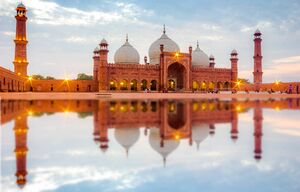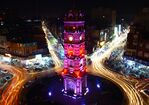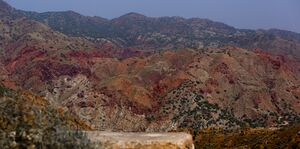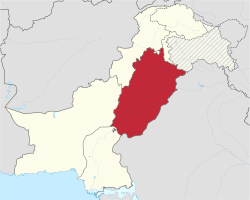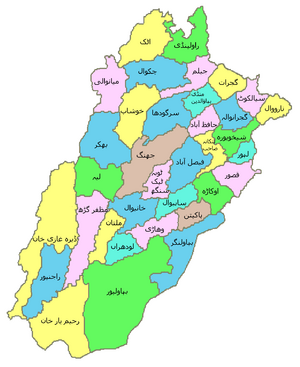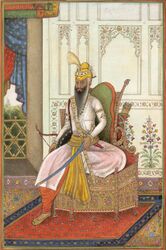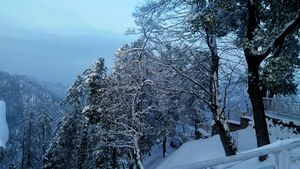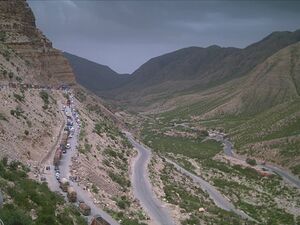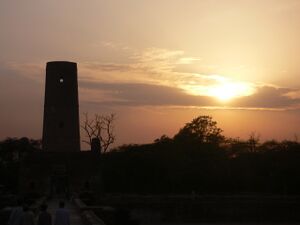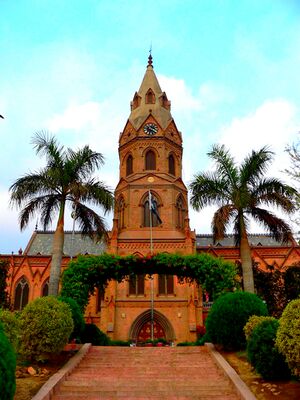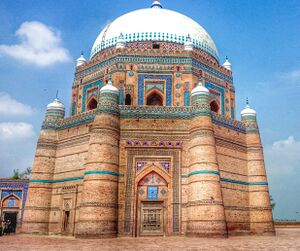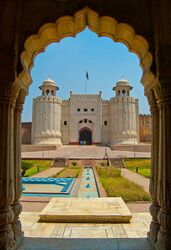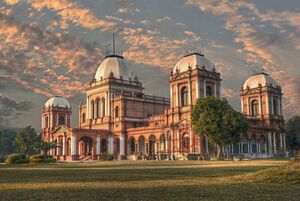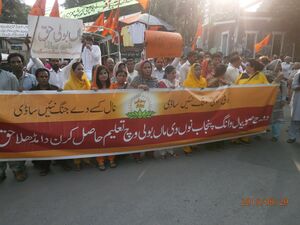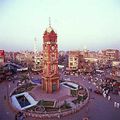الپنجاب، پاكستان
الپنجاب (Shahmukhi: پنجاب )، هو أحد أقاليم پاكستان. وهو من أكثر المناطق إكتظاظا بالسكان في البلاد[5] حيث يشكل 45% من إجمالي عدد سكان پاكستان. وهو موطن الپنجاب وجماعات أخرى مختلفة. ويحده من الجنوب السند، بلوچستان وإقليم التخوم الشمالية الغربية من الغرب، كشمير المدارة پاكستانياً، إسلام أباد من الشمال، وجمهورية الهند من الشرق وكشمير المدارة هندياً من الشمال الشرقي. اللغات الأساسية في البنجاب هي الپنجابية، أردو، السرايكي، المواتي والپوتواري والپاشتو. عاصمة الإقليم هي لاهور. اسم الپنجاب مترجم حرفيا من الفارسية[6] الكلمات Pañj (پنج)، وتعني خمسة، و Āb (آب) وتعني المياه. ولذلك كلمة پنجاب يمكن ترجمتها (أرض الخمسة أنهار، وذلك إشارة إلى أنهار Jhelum, Chenab, Ravi, Beas و Sutlej وهذه الأنهار الخمسة هي روافد نهر السند. وتأسس الإقليم في مايو 1972.
Punjab is Pakistan's most industrialized province, with the industrial sector comprising 24 percent of the province's gross domestic product.[7] It is known across Pakistan for its relative prosperity,[8] and has the lowest rate of poverty among all Pakistani provinces.[9][أ] However, a clear divide is present between the northern and southern portions of the province;[8] with poverty rates in northern Punjab being among the lowest in Pakistan,[10] while some in southern Punjab are among the most impoverished.[11] Punjab is also one of the most urbanized regions of South Asia, with approximately 40 percent of its population being concentrated in urban areas.[12]
It has been strongly influenced by Sufism, with numerous Sufi shrines spread across the province, attracting millions of devotees annually.[13] Guru Nanak, the founder of Sikhism, was born in the town of Nankana Sahib, near Lahore.[14][15][16] Punjab is also the site of the Katas Raj Temples, which feature prominently in Hindu mythology.[17] Several of the World Heritage Sites listed by UNESCO are located in Punjab, including the Shalimar Gardens, the Lahore Fort, the archaeological excavations at Taxila, and the Rohtas Fort, among others.[18]
أصل الاسم
Though the name Punjab is of Persian origin, its two parts (فارسية: پنج and فارسية: آب) are cognates of the Sanskrit words, بالسنسكريتية: पञ्च and بالسنسكريتية: अप्, of the same meaning.[19][20] The word pañjāb thus means 'The Land of Five Waters', referring to the rivers Jhelum, Chenab, Ravi, Sutlej, and Beas.[21] All are tributaries of the Indus River, the Sutlej being the largest. References to a land of five rivers may be found in the Mahabharata, which calls one of the regions in ancient Bharat Panchanada (بالسنسكريتية: पञ्चनद).[22][23] Persian place names are very common in Northwest India and Pakistan. The ancient Greeks referred to the region as Pentapotamía (باليونانية: Πενταποταμία),[24][25][26] which has the same meaning as the Persian word.
التاريخ
العصر القديم
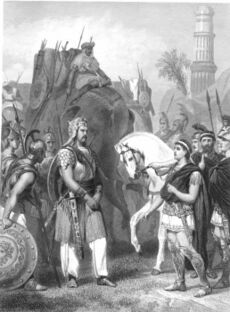 أحد الملوك الأوائل المعروفين في الپنجاب القديمة، Porus الذي قاتل ضد الإسكندر الأكبر. |
The Punjab region is noted as the site of one of the earliest urban societies, the Indus Valley Civilization that flourished from about 3000 B.C. and declined rapidly 1,000 years later, following the Indo-Aryan migrations that overran the region in waves between 1500 and 500 B.C.[27] Frequent intertribal wars stimulated the growth of larger groupings ruled by chieftains and kings, who ruled local kingdoms known as Mahajanapadas.[27] The rise of kingdoms and dynasties in the Punjab is chronicled in the ancient Hindu epics, particularly the Mahabharata.[27] Kaspatyrus or Multan was briefly conquered by Darius the great's army and included in his extensive empire.[28]
Multan was the noted centre of excellence of the region which was attacked by Greek army led by Alexander the Great. The Mali tribe together with nearby tribes gathered an army of 90,000 personnel to face Greek army. This was the largest army faced by Greeks in entire subcontinent. During the siege of the city's citadel, the Alexander leaped into the inner area of the citadel, where he killed the Mallians' leader. Alexander was wounded by an arrow that had penetrated his lung, leaving him severely injured. The city was conquered after a fierce battle.[29]
In 326 B.C. The earliest known notable local king of this region was known as Porus, who fought the famous Battle of the Hydaspes against Alexander the Great. His kingdom spanned between rivers Hydaspes (Jhelum) and Acesines (Chenab); Strabo had held the territory to contain almost 300 cities.[30] He (alongside Abisares) had a hostile relationship with the Kingdom of Taxila which was ruled by his extended family.[30] When the armies of Alexander crossed Indus in its eastward migration, probably in Udabhandapura, he was greeted by the-then ruler of Taxila, Omphis and was immediately surrendered to him without a battle. [30]
Omphis had hoped to force both Porus and Abisares into submission leveraging the might of Alexander's forces and diplomatic missions were mounted, but while Abisares accepted the submission, Porus refused.[30] This led Alexander to seek for a face-off with Porus.[30] Thus began the Battle of the Hydaspes in 326 BC; the exact site remains unknown.[30] The battle is thought to be resulted in a decisive Greek victory; however, A. B. Bosworth warns against an uncritical reading of Greek sources who were obviously exaggerative.[30] Alexander later founded two cities—Nicaea at the site of victory and Bucephalous at the battle-ground, in memory of his horse, who died soon after the battle.[30][ب] Later, tetradrachms would be minted depicting Alexander on horseback, armed with a sarissa and attacking a pair of Indians on an elephant.[30][31] Porus refused to surrender and wandered about atop an elephant, until he was wounded and his force routed.[30] When asked by Alexander how he wished to be treated, Porus replied "Treat me as a king would treat another king".[32] Despite the apparently one-sided results, Alexander was impressed by Porus and chose to not depose him.[33][34][35] Not only was his territory reinstated but also expanded with Alexander's forces annexing the territories of Glausaes, who ruled to the northeast of Porus' kingdom.[33] After Alexander's death in 323 BCE, Perdiccas became the regent of his empire, and after Perdiccas's murder in 321 BCE, Antipater became the new regent.[36] According to Diodorus, Antipater recognized Porus's authority over the territories along the Indus River. However, Eudemus, who had served as Alexander's satrap in the Punjab region, treacherously killed Porus.[37] The battle is historically significant because it resulted in the syncretism of ancient Greek political and cultural influences to the Indian subcontinent, yielding works such as Greco-Buddhist art, which continued to have an impact for the ensuing centuries. The region was then divided between the Maurya Empire and the Greco-Bactrian kingdom in 302 B.C.E. Menander I Soter conquered Punjab and made Sagala (present-day Sialkot) the capital of the Indo-Greek Kingdom.[38][39] Menander is noted for having become a patron and convert to Greco-Buddhism and he is widely regarded as the greatest of the Indo-Greek kings.[40] Greek influence in the region ended around 12 B.C.E. when the Punjab fell under the Sassanids.
العصر الوسيط
Islam emerged as the major power in Punjab after the Umayyad caliphate led by Muhammad bin Qasim conquered the region in 711 AD.[27] The city of Multan became a center of the Ismaili sect of Islam. Umayyads after conquering key cities of Uch and Multan inhabited thousands of Arabs (10,000) in Multan, These Arabs ruled the vast areas of Punjab for next 3 centuries. From their capital in Multan they ruled the far areas of Kashmir. Islam spread rapidly.[[#cite_note-FOOTNOTEAmjad1989[[تصنيف:مقالات_بالمعرفة_بحاجة_لذكر_رقم_الصفحة_بالمصدر_from_September_2022]][[Category:Articles_with_invalid_date_parameter_in_template]]<sup_class="noprint_Inline-Template_"_style="white-space:nowrap;">[<i>[[المعرفة:Citing_sources|<span_title="هذه_المقولة_تحتاج_مرجع_إلى_صفحة_محددة_أو_نطاق_من_الصفحات_تظهر_فيه_المقولة'"`UNIQ--nowiki-00000046-QINU`"'_(September_2022)">صفحة مطلوبة</span>]]</i>]</sup>-43|[41]]][42]
In the ninth century, the Hindu Shahi dynasty originating from the region of Oddiyana replaced the Taank kingdom in the Punjab, ruling much of Punjab along with eastern Afghanistan.[27][43][44] In the 10th century, the tribe of the Gakhars/Khokhars, formed a large part of the Hindu Shahi army according to the Persian historian Firishta.[45]
الغزنوي
The Turkic Ghaznavids in the tenth century attacked the regions of Punjab. Multan and Uch were conquered after 3 attacks and Multan's Arab ruler Abul Fateh Daud was defeated, thousands of Ismailis were killed or mutilated according to 11th century scholar Abu Mansur al-Baghdadi, though the community was not extinguished,[46] famous Sun Temple was destroyed. This ended the 3 centuries Arab rule over Punjab.[[#cite_note-FOOTNOTEAmjad1989[[تصنيف:مقالات_بالمعرفة_بحاجة_لذكر_رقم_الصفحة_بالمصدر_from_September_2022]][[Category:Articles_with_invalid_date_parameter_in_template]]<sup_class="noprint_Inline-Template_"_style="white-space:nowrap;">[<i>[[المعرفة:Citing_sources|<span_title="هذه_المقولة_تحتاج_مرجع_إلى_صفحة_محددة_أو_نطاق_من_الصفحات_تظهر_فيه_المقولة'"`UNIQ--nowiki-0000004E-QINU`"'_(September_2022)">صفحة مطلوبة</span>]]</i>]</sup>-49|[47]]] Ghaznavids overthrew the Hindu Shahis and consequently ruled for 157 years, gradually declining as a power until the Ghurid conquests of key Punjab cities of Uch, Multan and Lahore by Muhammad of Ghor in 1186, deposing the last Ghaznavid ruler Khusrau Malik.[[#cite_note-FOOTNOTEAmjad1989[[تصنيف:مقالات_بالمعرفة_بحاجة_لذكر_رقم_الصفحة_بالمصدر_from_September_2022]][[Category:Articles_with_invalid_date_parameter_in_template]]<sup_class="noprint_Inline-Template_"_style="white-space:nowrap;">[<i>[[المعرفة:Citing_sources|<span_title="هذه_المقولة_تحتاج_مرجع_إلى_صفحة_محددة_أو_نطاق_من_الصفحات_تظهر_فيه_المقولة'"`UNIQ--nowiki-00000050-QINU`"'_(September_2022)">صفحة مطلوبة</span>]]</i>]</sup>-50|[48]]][49]
Following the death of Muhammad of Ghor in 1206, the Ghurid state fragmented and was replaced in northern India by the Delhi Sultanate and for some time independent sultanates ruled by various Sultans.[[#cite_note-FOOTNOTEAmjad1989[[تصنيف:مقالات_بالمعرفة_بحاجة_لذكر_رقم_الصفحة_بالمصدر_from_September_2022]][[Category:Articles_with_invalid_date_parameter_in_template]]<sup_class="noprint_Inline-Template_"_style="white-space:nowrap;">[<i>[[المعرفة:Citing_sources|<span_title="هذه_المقولة_تحتاج_مرجع_إلى_صفحة_محددة_أو_نطاق_من_الصفحات_تظهر_فيه_المقولة'"`UNIQ--nowiki-00000053-QINU`"'_(September_2022)">صفحة مطلوبة</span>]]</i>]</sup>-52|[50]]] The Delhi Sultanate ruled the Punjab for the next three hundred years, led by five unrelated dynasties, the Mamluks, Khalajis, Tughlaqs, Sayyids and Lodis.
تغلق
Ghiyath al Din Tughlaq, the former governor of Multan and Dipalpur founded Tughlaq dynasty in Delhi and ruled the subcontinent region . Earlier he served as the governor of Multan and fought 28 battles against Mongols from there and saved Punjab and Sindh regions from advances of Mongols and had survived. After his death his son Muhammad Tughlaq became the emperor.[[#cite_note-FOOTNOTEAmjad1989[[تصنيف:مقالات_بالمعرفة_بحاجة_لذكر_رقم_الصفحة_بالمصدر_from_September_2022]][[Category:Articles_with_invalid_date_parameter_in_template]]<sup_class="noprint_Inline-Template_"_style="white-space:nowrap;">[<i>[[المعرفة:Citing_sources|<span_title="هذه_المقولة_تحتاج_مرجع_إلى_صفحة_محددة_أو_نطاق_من_الصفحات_تظهر_فيه_المقولة'"`UNIQ--nowiki-00000055-QINU`"'_(September_2022)">صفحة مطلوبة</span>]]</i>]</sup>-53|[51]]]
الغزو المنغولي
15th century saw rise of many prominent Muslims from Punjab. Khizr Khan established the Sayyid dynasty, the fourth dynasty of the Delhi Sultanate after the fall of the Tughlaqs.[52]
In 1398, Timur attacked the Punjab region. After his invasion, Khizr Khan established the fourth dynasty of the Delhi Sultanate. According to Richard M. Eaton, Khizr Khan was son of a Punjabi chieftain.[52] He was a Khokhar chieftain who travelled to Samarkand and profited from the contacts he made with the Timurid society[54] Later on, Delhi Sultanate, weakened by invasion of Emir Timur, could not control all regions of the Empire and different local kingdoms appeared.
سلطنة لنگاه
In 1445, Sultan Qutbudin, chief of Langah, a Jat Zamindar tribe[55][56][57][58] established the Langah Sultanate in Multan. The Sultanate included regions of southern and central Punjab and areas of Khyber and Balochistan. A large number of Baloch settlers arrived and towns of Dera Ghazi Khan and Dera Ismail Khan were founded.[[#cite_note-FOOTNOTERoseberry1987[[تصنيف:مقالات_بالمعرفة_بحاجة_لذكر_رقم_الصفحة_بالمصدر_from_September_2022]][[Category:Articles_with_invalid_date_parameter_in_template]]<sup_class="noprint_Inline-Template_"_style="white-space:nowrap;">[<i>[[المعرفة:Citing_sources|<span_title="هذه_المقولة_تحتاج_مرجع_إلى_صفحة_محددة_أو_نطاق_من_الصفحات_تظهر_فيه_المقولة'"`UNIQ--nowiki-0000005F-QINU`"'_(September_2022)">صفحة مطلوبة</span>]]</i>]</sup>-61|[59]]]
During the most of 15th century, the Khokhars and Gakhars tribe were in general revolt in the Pothohar region. Jasrath Khokhar was one of their major chiefs who helped Sultan Zain Ul Abideen of Kashmir to gain his throne and ruled over vast tracts of Jammu and North Punjab. He also conquered Delhi for a brief period in 1431 but was driven out by Mubarak Shah.[60]
العصر الحديث
The Mughals came to power in the early sixteenth century and gradually expanded to control all of the Punjab.[61] During Mughal period Punjab region was divided into two provinces; Province of Multan and Province of Lahore. The Mughal Empire ruled the region until it was severely weakened in the eighteenth century.[27] As Mughal power weakened, Afghan rulers took control of the region.[27] Contested by Marathas and Afghans, the region was the center of the growing influence of the Sikhs, who expanded and established the Sikh empire as the Mughals and Afghans weakened, ultimately ruling the Punjab and territories north into the Himalayas.[27]
The Sikh Empire ruled the Punjab until the British annexed it in 1849 following the First and Second Anglo-Sikh Wars.[62]
الحكم البريطاني
Most of the Punjabi homeland formed a province of British India, though a number of small princely states retained local rulers who recognized British authority.[27] The Punjab with its rich farmlands became one of the most important colonial assets.[27] Lahore was a noted center of learning and culture, and Rawalpindi became an important military installation.[27]
Most Punjabis supported the British during World War I, providing men and resources to the war effort even though the Punjab remained a source of anti colonial activities.[63] Disturbances in the region increased as the war continued.[27] At the end of the war, high casualty rates, heavy taxation, inflation, and a widespread influenza epidemic disrupted Punjabi society.[27] In 1919 a British officer ordered his troops to fire on a crowd of demonstrators, mostly Sikhs in Amritsar. The Jallianwala massacre fueled the indian independence movement.[27] Nationalists declared the independence of India from Lahore in 1930 but were quickly suppressed.[27]
When the Second World War broke out, nationalism in British India had already divided into religious movements.[27] Many Sikhs and other minorities supported the Hindus, who promised a secular multicultural and multireligious society, and Muslim leaders in Lahore passed a resolution to work for a Muslim Pakistan, making the Punjab region a center of growing conflict between Indian and Pakistani nationalists.[27] At the end of the war, the British granted separate independence to India and Pakistan, setting off massive communal violence as Muslims fled to Pakistan and Hindu and Sikh Punjabis fled east to India.[27]
The British Raj had major political, cultural, philosophical, and literary consequences in the Punjab, including the establishment of a new system of education. During the independence movement, many Punjabis played a significant role, including Madan Lal Dhingra, Sukhdev Thapar, Ajit Singh Sandhu, Bhagat Singh, Udham Singh, Kartar Singh Sarabha, Bhai Parmanand, Choudhry Rahmat Ali, and Lala Lajpat Rai. At the time of partition in 1947, the province was split into East and West Punjab. East Punjab (48%) became part of India, while West Punjab (52%) became part of Pakistan.[64] The Punjab bore the brunt of the civil unrest following partition, with casualties estimated to be in the millions.[65][66][67][68]
Another major consequence of partition was the sudden shift towards religious homogeneity occurred in all districts across Punjab owing to the new international border that cut through the province. This rapid demographic shift was primarily due to wide scale migration but also caused by large-scale religious cleansing riots which were witnessed across the region at the time. According to historical demographer Tim Dyson, in the eastern regions of Punjab that ultimately became Indian Punjab following independence, districts that were 66% Hindu in 1941 became 80% Hindu in 1951; those that were 20% Sikh became 50% Sikh in 1951. Conversely, in the western regions of Punjab that ultimately became Pakistani Punjab, all districts became almost exclusively Muslim by 1951.[69]
الجغرافيا
Punjab is Pakistan's second largest province by area after Balochistan with an area of 205,344 square kilometres (79,284 square miles).[70] It occupies 25.8% of the total landmass of Pakistan.[70] Punjab province is bordered by Sindh to the south, the province of Balochistan to the southwest, the province of Khyber Pakhtunkhwa to the west, and the Islamabad Capital Territory and Azad Kashmir in the north. Punjab borders Jammu and Kashmir in the north, and the Indian states of Punjab and Rajasthan to the east.
The capital and largest city is Lahore which was the capital of the wider Punjab region since 17th century. Other important cities include Faisalabad, Rawalpindi, Gujranwala, Sargodha, Multan, Sialkot, Bahawalpur, Gujrat, Sheikhupura, Jhelum and Sahiwal. The undivided Punjab region was home to six rivers, of which five flow through Pakistan's Punjab province. From west to east, the rivers are: the Indus, Jhelum, Chenab, Ravi and Sutlej. It is the nation's only province that touches every other province; it also surrounds the federal enclave of the national capital city at Islamabad.[71][72]
الطبوغرافيا
Punjab's landscape consists mostly consists of fertile alluvial plains of the Indus River and its four major tributaries in Pakistan, the Jhelum, Chenab, Ravi, and Sutlej rivers which traverse Punjab north to south – the fifth of the "five waters" of Punjab, the Beas River, lies exclusively in the Indian state of Punjab. The landscape is amongst the most heavily irrigated on earth and canals can be found throughout the province. Punjab also includes several mountainous regions, including the Sulaiman Mountains in the southwest part of the province, the Margalla Hills in the north near Islamabad, and the Salt Range which divides the most northerly portion of Punjab, the Pothohar Plateau, from the rest of the province. Sparse deserts can be found in southern Punjab near the border with Rajasthan and near the Sulaiman Range. Punjab also contains part of the Thal and Cholistan deserts. In the South, Punjab's elevation reaches 2,327 metres (7,635 ft)[بحاجة لمصدر] near the hill station of Fort Munro in Dera Ghazi Khan.
المناخ
Most areas in Punjab experience extreme weather with foggy winters, often accompanied by rain. By mid-February the temperature begins to rise; springtime weather continues until mid-April, when the summer heat sets in. The onset of the southwest monsoon is anticipated to reach Punjab by May, but since the early 1970s, the weather pattern has been irregular. The spring monsoon has either skipped over the area or has caused it to rain so hard that floods have resulted. June and July are oppressively hot. Although official estimates rarely place the temperature above 46 °C, newspaper sources claim that it reaches 51 °C and regularly carry reports about people who have succumbed to the heat. Heat records were broken in Multan in June 1993, when the mercury was reported to have risen to 54 °C. In August the oppressive heat is punctuated by the rainy season, referred to as barsat, which brings relief in its wake. The hardest part of the summer is then over, but cooler weather does not come until late October.
Recently the province experienced one of the coldest winters in the last 70 years.[73]
Punjab's region temperature ranges from −2° to 45 °C, but can reach 50 °C (122 °F) in summer and can touch down to −10 °C in winter.
Climatically, Punjab has three major seasons:[74]
- Hot weather (April to June) when temperature rises as high as 123 °F (51 °C).
- Rainy season (July to September). Average rainfall annual ranges between 96 cm sub-mountain region and 46 cm in the plains.
- Cold / Foggy / mild weather (October to March). Temperature goes down as low as 35.6 °F (2.0 °C).
Weather extremes are notable from the hot and barren south to the cool hills of the north. The foothills of the Himalayas are found in the extreme north as well, and feature a much cooler and wetter climate, with snowfall common at higher altitudes.[بحاجة لمصدر]
السكان
| Historical population figures[75][76][ت] | |||
|---|---|---|---|
| Census | Population | Urban | Rural |
|
| |||
| 1941 | 17,350,103 | N/A | N/A |
| 1951 | 20,540,762 | 3,568,076 | 16,972,686 |
| 1961 | 25,463,974 | 5,475,922 | 19,988,052 |
| 1972 | 37,607,423 | 9,182,695 | 28,424,728 |
| 1981 | 47,292,441 | 13,051,646 | 34,240,795 |
| 1998 | 73,621,290 | 23,019,025 | 50,602,265 |
| 2017 | 110,012,615 | 40,401,164 | 70,008,451 |
التعداد
The province is home to over half the population of Pakistan, and is the world's fifth-most populous subnational entity, and the most populous outside China or India.
الأديان
According to the 2017 census, the population of Punjab, Pakistan is was 109,989,655.[77] With 107,541,602 adherents, Muslims comprise the largest religious group, with a Sunni Hanafi majority and a Shia Ithna 'ashariyah minority, forming approximately 97.8 percent of the population.[77] The largest non-Muslim minority is Christians with 2,063,063 adherents, forming roughly 1.9 percent of the population.[77] Hindus form 211,641 people, comprising approximately 0.2 percent of the population.[77] The other minorities include Sikhs, Parsis and Baháʼís.[77][79]
| Religious group |
1941[80][ت] | 1951[81] | 1998[82] | 2017[77][79] | ||||
|---|---|---|---|---|---|---|---|---|
| تع. | % | Pop. | % | Pop. | % | Pop. | % | |
| الإسلام |
13,022,160 | 75.06% | 20,200,794 | 97.89% | 71,574,830 | 97.22% | 107,541,602 | 97.77% |
| الهندوسية |
2,373,466 | 13.68% | 33,052 | 0.16% | 116,410 | 0.16% | 211,641 | 0.19% |
| السيخية |
1,530,112 | 8.82% | N/A | N/A | N/A | N/A | N/A | N/A |
| المسيحية |
395,311 | 2.28% | 402,617 | 1.95% | 1,699,843 | 2.31% | 2,063,063 | 1.88% |
| الجاينية |
9,520 | 0.05% | N/A | N/A | N/A | N/A | N/A | N/A |
| الأحمدية |
N/A | N/A | N/A | N/A | 181,428 | 0.25% | 158,021 | 0.14% |
| Others[ج] | 19,534 | 0.11% | 239 | 0% | 48,779 | 0.07% | 15,328 | 0.01% |
| التعداد الإجمالي | 17,350,103 | 100% | 20,636,702 | 100% | 73,621,290 | 100% | 109,989,655 | 100% |
اللغات
The major native language spoken in the Punjab is Punjabi, representing the largest language spoken in the country. Punjabi is recognized as the provincial language of Punjab but is not given any official recognition in the Constitution of Pakistan at the national level.
Several languages closely related to Punjabi are spoken in the periphery of the region. In the southern half of Punjab, the majority language is Saraiki, while in the north there are speakers of Hindko and Pothwari.[84]
Pashto is also spoken in some parts of Punjab, especially in Attock, Mianwali and Rawalpindi districts.[85]
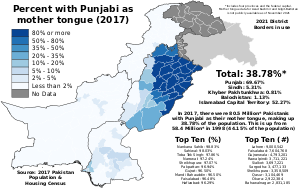
حكومة الإقليم
الأضلع
يوجد 35 ضلع في الپنجاب، پاكستان[86].
رموز إقليم الپنجاب الپاكستاني
الاقتصاد
Punjab has the largest economy in Pakistan, contributing most to the national GDP. The province's economy has quadrupled since 1972.[87] Its share of Pakistan's GDP was 54.7% in 2000 and 59% as of 2010. It is especially dominant in the service and agriculture sectors of Pakistan's economy. With its contribution ranging from 52.1% to 64.5% in the Service Sector and 56.1% to 61.5% in the agriculture sector. It is also a major manpower contributor because it has the largest pool of professionals and highly skilled (technically trained) manpower in Pakistan. It is also dominant in the manufacturing sector, though the dominance is not as huge, with historical contributions ranging from a low of 44% to a high of 52.6%.[88] In 2007, Punjab achieved a growth rate of 7.8%[89] and during the period 2002–03 to 2007–08, its economy grew at a rate of between 7% to 8% per year.[90] and during 2008–09 grew at 6% against the total GDP growth of Pakistan at 4%.
Despite the lack of a coastline, Punjab is the most industrialised province of Pakistan;[7] its manufacturing industries produce textiles, sports goods, heavy machinery, electrical appliances, surgical instruments, vehicles, auto parts, metals, sugar mill plants, aircraft, cement, agricultural machinery, bicycles and rickshaws, floor coverings, and processed foods. In 2003, the province manufactured 90% of the paper and paper boards, 71% of the fertilizers, 69% of the sugar and 40% of the cement of Pakistan.[91]

Lahore and Gujranwala Divisions have the largest concentration of small light engineering units. The district of Sialkot excels in sports goods, surgical instruments and cutlery goods. Industrial estates are being developed by Punjab government to boost industrialization in province, Quaid e Azam Business Park Sheikhupura is one of the industrial area which is being developed near Sheikhupura on Lahore-Islamabad motorway.[93]
Punjab has the lowest poverty rates in Pakistan, although a divide is present between the northern and southern parts of the province.[8] Sialkot District in the prosperous northern part of the province has a poverty rate of 5.63%,[94] while Rajanpur District in the poorer south has a poverty rate of 60.05%.[11]
التعليم
The literacy rate has increased greatly over the last 40 years (see the table below). Punjab has the highest Human Development Index out of all of Pakistan's provinces at 0.564.[3]
| Year | Literacy Rate |
|---|---|
| 1972 | 20.7% |
| 1981 | 27.4% |
| 1998 | 46.56% |
| 2009 | 59.6% |
| 2021 | 66.3%[95] |
This is a chart of the education market of Punjab estimated by the government in 1998.
| Qualification | Urban | Rural | Total | Enrollment Ratio(%) |
|---|---|---|---|---|
| – | 23,019,025 | 50,602,265 | 73,621,290 | — |
| Below Primary | 3,356,173 | 11,598,039 | 14,954,212 | 100.00 |
| Primary | 6,205,929 | 18,039,707 | 24,245,636 | 79.68 |
| Middle | 5,140,148 | 10,818,764 | 15,958,912 | 46.75 |
| Matriculation | 4,624,522 | 7,119,738 | 11,744,260 | 25.07 |
| Intermediate | 1,862,239 | 1,821,681 | 3,683,920 | 9.12 |
| BA, BSc... degrees | 110,491 | 96,144 | 206,635 | 4.12 |
| MA, MSc... degrees | 1,226,914 | 764,094 | 1,991,008 | 3.84 |
| Diploma, Certificate... | 418,946 | 222,649 | 641,595 | 1.13 |
| Other qualifications | 73,663 | 121,449 | 195,112 | 0.26 |
قائمة الجامعات
الثقافة
The culture in Punjab grew out of the settlements along the five rivers, which served as an important route to the Near East as early as the ancient Indus Valley civilization, dating back to 3000 BCE.[100] Agriculture has been the major economic feature of the Punjab and has therefore formed the foundation of Punjabi culture, with one's social status being determined by landownership.[100] The Punjab emerged as an important agricultural region, especially following the Green Revolution during the mid-1960's to the mid-1970's, has been described as the "breadbasket of both India and Pakistan".[100]
Fairs and festivals
The Islamic festivals are typically observed.[101][102] Non-Islamic festivals include Lohri, Basant and Vaisakhi, which are usually celebrated as seasonal festivals.[103] The Islamic festivals are set according to the lunar Islamic calendar (Hijri), and the date falls earlier by 10 to 13 days from year to year.[104]
Some Islamic clerics and some politicians have attempted to ban the participation of non-Islamic festivals because of the religious basis,[105] and they being declared haram (forbidden in Islam).[106]
السياحة
Tourism in Punjab is regulated by the Tourism Development Corporation of Punjab.[107] The province has a number of large cosmopolitan cities, including the provincial capital Lahore. Major visitor attractions there include Lahore Fort and Shalimar Gardens, which are now recognised World Heritage Sites. The Walled City of Lahore, Badshahi Mosque, Wazir Khan Mosque, Tomb of Jahangir and Nur Jahan, Tomb of Asaf Khan, Chauburji and other major sites visited by tourists each year.
Murree is a famous hill station stop for tourists.[108] The Pharwala Fort, which was built by an ancient Hindu civilisation, is on the outskirts of the city. The city of Sheikhupura also has a number of sites from the Mughal Empire, including the World Heritage-listed Rohtas Fort near Jhelum. The Katasraj temple in the city of Chakwal is a major destination for Hindu devotees. The Khewra Salt Mines is one of the oldest mines in South Asia. Faisalabad's clock tower and eight bazaars were designed to represent the Union Jack.[109]
The province's southward is arid. Multan is known for its mausoleums of saints and Sufi pirs. The Multan Museum, Multan fort, DHA 360° zoo and Nuagaza tombs are significant attractions in the city. The city of Bahawalpur is located near the Cholistan and Thar deserts. Derawar Fort in the Cholistan Desert is the site for the annual Cholistan Jeep Rally. The city is also near the ancient site of Uch Sharif which was once a Delhi Sultanate stronghold. The Noor Mahal, Sadiq Ghar Palace, Darbar Mall were built during the reign of the Nawabs. The Lal Suhanra National Park is a major zoological garden on the outskirts of the city.[بحاجة لمصدر]
Social issues
The use of Urdu and English as the near exclusive languages of broadcasting, the public sector, and formal education have led some to fear that the Punjabi language in the province is being relegated to a low-status language and that it is being denied an environment where it can flourish.[110][111][112][113]
In August 2015, the Pakistan Academy of Letters, International Writer's Council (IWC) and World Punjabi Congress (WPC) organised the Khawaja Farid Conference and demanded that a Punjabi-language university should be established in Lahore and that Punjabi language should be declared as the medium of instruction at the primary level.[114][115] In September 2015, a case was filed in Supreme Court of Pakistan against Government of Punjab, Pakistan as it did not take any step to implement the Punjabi language in the province.[116][117] Additionally, several thousand Punjabis gather in Lahore every year on International Mother Language Day.
Hafiz Saeed, chief of Jama'at-ud-Da'wah (JuD) has questioned Pakistan's decision to adopt Urdu as its national language in a country where majority of people speak Punjabi language, citing his interpretation of Islamic doctrine as encouraging education in the mother-tongue.[118] Some of the organisations and activists that demand the promotion of the Punjabi language include:
- Cultural and research institutes: Punjabi Adabi Board, the Khoj Garh Research Centre, Punjabi Prachar, Institute for Peace and Secular Studies, Adbi Sangat, Khaaksaar Tehreek, Saanjh, Maan Boli Research Centre, Punjabi Sangat Pakistan, Punjabi Markaz, Sver International
- Trade unions and youth groups: Punjabi Writers Forum, National Students Federation, Punjabi Union-Pakistan, Punjabi National Conference, National Youth Forum, Punjabi Writers Forum, National Students Federation, Punjabi Union, Pakistan, and the Punjabi National Conference.
- Notable activists include Tariq Jatala, Farhad Iqbal, Diep Saeeda, Khalil Ojla, Afzal Sahir, Jamil Ahmad Paul, Mazhar Tirmazi, Mushtaq Sufi, Biya Je, Tohid Ahmad Chattha and Bilal Shaker Kahaloon, Nazeer Kahut[119][120][121]
أعلام الپنجاب
- محمد إقبال, lawyer, politician, revolutionary, philosopher, visionary, and a truely legendary mystic poet.
- ابن إنشاء, poet, writer(travelogues, humor).
- Col. Muhammad Khan, writer, columnist, military education specialist.
- فضل إلهي شودري, late President of Pakistan.
- Qudrat Ullah Shahab, writer, bureaucrat.
- Shah Hussein
- Shoaib Akhtar, cricketer.
- Wasim Akram, cricketer and sports presenter.
- Waris Shah, sufi poet, mystic philosopher
- Chaudhry Pervaiz Elahi, politician and industrialist.
- Faiz Ahmed Faiz, poet accredited for some of the most sophisticated romantic poetry in Urdu language.
- Chaudhry Shujaat Hussain, politician and industrialist.
- A. R. Hye, architect
- Noor Jehan, singer.
- Alam Lohar, folk singer.
- Arif Lohar, folk singer.
- Abdul Hafeez Kardar
- عبد السلام، فيزيائي حاصل على جائزة نوبل.
- انضمام الحق, cricketer.
- عمران خان, cricketer, politician and philanthropist.
- Nawabzada Nasrullah Khan, politician
- نصرت فاتح علي خان, singer, musician.
- Mian Mir, saint revered by Sikhs and Muslims.
- Sultan Rahi, actor.
- Rangeela, actor, comedian
- نواز شريف, politician and industrialist.
- Shahbaz Sharif, politician and industrialist.
- Waqar Younis, cricketer and sports presenter.
- Makhdoom Javed Hashmi, politician
- Shah Mehmood Qureshi, politician
- Salman Butt, cricketer
- Shoaib Malik, cricketer
- Ahsan Iqbal, politician
- Atif Aslam, singer
- Rae Ahmed Nawaz Khan Kharal
معرض صور
The Shalimar Gardens in Lahore
Taxila is a World Heritage Site
انظر أيضاً
- List of Jat Clans of West Punjab
- Hindu and Buddhist heritage of Pakistan
- تاريخ الپنجاب
- منطقة الپنجاب
- پنجاب، الهند
- شعب الپنجاب
- ثقافة پنجابية
- Kotli Loharan West
ملاحظات
- ^ Islamabad Capital Territory is Pakistan's least impoverished administrative unit, but ICT is not a province. Azad Kashmir also has a rate of poverty lower than Punjab, but is not a province.
- ^ Craterus supervised the construction. These cities are yet to be identified.
- ^ أ ب 1941 figure taken from census data by combining the total population of all districts (Lahore, Sialkot, Gujranwala, Sheikhupura, Gujrat, Shahpur, Jhelum, Rawalpindi, Attock, Mianwali, Montgomery, Lyallpur, Jhang, Multan, Muzaffargargh, Dera Ghazi Khan), one tehsil (Shakargarh – then part of Gurdaspur District), one princely state (Bahawalpur), and one tract (Biloch Trans–Frontier) in Punjab Province, British India that ultimately fell on the western side of the Radcliffe Line. See 1941 census data here: [76]
Immediately following the partition of India in 1947, these districts and tract would ultimately make up the subdivision of West Punjab, which also later included Bahawalpur. The state that makes up this region in the contemporary era is Punjab, Pakistan. - ^ 1941 census: Including Ad-Dharmis
- ^ 1941 census: Including Buddhism, Zoroastrianism, Judaism, Tribals, others, or not stated
2017 census: Also includes Sikhs, Parsis, Baháʼís, others, and not stated
الهوامش
- ^ "Punjab chief secretary directs timely utilisation of funds". Bol News. 17 January 2022. Retrieved 20 January 2022.
- ^ 2017 Census Archived 15 أكتوبر 2017 at the Wayback Machine
- ^ أ ب "Sub-national HDI - Area Database - Global Data Lab". hdi.globaldatalab.org (in الإنجليزية). Retrieved 8 August 2021. خطأ استشهاد: وسم
<ref>غير صالح؛ الاسم "Subnational HDR" معرف أكثر من مرة بمحتويات مختلفة. - ^ "Provincial Assembly – Punjab". Archived from the original on 1 فبراير 2009.
- ^ Government of the Punjab
- ^ Singh, Pritam (2008). Federalism, Nationalism and Development: India and the Punjab Economy. London; New York: Routledge. p. 3. ISBN 0415456665.
- ^ أ ب Government of the Punjab – Planning & Development Department (March 2015). "PUNJAB GROWTH STRATEGY 2018 Accelerating Economic Growth and Improving Social Outcomes" (PDF). Archived (PDF) from the original on 29 March 2017. Retrieved 14 July 2016.
The industrial sector of Punjab employs around 23% of the province's labour force and contributes 24% to the provincial GDP
- ^ أ ب ت Farooqui, Tashkeel (20 June 2016). "Northern Punjab, urban Sindh people more prosperous than rest of country: report". The Express Tribune. Archived from the original on 24 July 2016. Retrieved 14 July 2016.
- ^ Arif, G. M. "Poverty Profile of Pakistan" (PDF). Benazir Income Support Programme. Government of Pakistan. Archived from the original (PDF) on 13 December 2016. Retrieved 14 July 2016.
Among the four provinces, the highest incidence of poverty is found in Sindh (45%), followed by Balochistan (44%), Khyber Pakhtukhaw (KP) (37%) and Punjab (21%)
- ^ Arif, G. M. "Poverty Profile of Pakistan" (PDF). Benazir Income Support Programme. Government of Pakistan. Archived from the original (PDF) on 13 December 2016. Retrieved 14 July 2016.
See Table 5, Page 12 "Sialkot District"
- ^ أ ب Arif, G. M. "Poverty Profile of Pakistan" (PDF). Benazir Income Support Programme. Government of Pakistan. Archived from the original (PDF) on 13 December 2016. Retrieved 14 July 2016.
See Table 5, Page 12 "Rajanpur District"
- ^ Government of the Punjab – Planning & Development Department (March 2015). "PUNJAB GROWTH STRATEGY 2018 Accelerating Economic Growth and Improving Social Outcomes" (PDF). Archived (PDF) from the original on 29 March 2017. Retrieved 14 July 2016.
Punjab is among the most urbanized regions of South Asia and is experiencing a consistent and long-term demographic shift of the population to urban regions and cities, with around 40% of the province's population living in urban areas
- ^ Gilmartin, David (1988). Empire and Islam: Punjab and the Making of Pakistan. University of California Press. pp. 40–41.
- ^ Macauliffe, Max Arthur (2004) [1909]. The Sikh Religion – Its Gurus, Sacred Writings and Authors. India: Low Price Publications. ISBN 81-86142-31-2.
- ^ Singh, Khushwant (2006). The Illustrated History of the Sikhs. India: Oxford University Press. pp. 12–13. ISBN 0-19-567747-1.
- ^ Malik, Iftikhar Haider (2008). The History of Pakistan. Greenwood Publishing Group.
- ^ "Katas Raj Temples". Temple Darshan. Archived from the original on 18 August 2016. Retrieved 14 July 2016.
- ^ "Properties inscribed on the World Heritage List (Pakistan)". UNESCO. UNESCO. Archived from the original on 4 July 2016. Retrieved 14 July 2016.
- ^ H K Manmohan Siṅgh. "The Punjab". The Encyclopedia of Sikhism, Editor-in-Chief Harbans Singh. Punjabi University, Patiala. Archived from the original on 5 March 2016. Retrieved 18 August 2015.
- ^ Gandhi, Rajmohan (2013). Punjab: A History from Aurangzeb to Mountbatten. New Delhi, India, Urbana, Illinois: Aleph Book Company. p. 1 ("Introduction"). ISBN 978-93-83064-41-0.
- ^ "Punjab." Pp. 107 in Encyclopædia Britannica (9th ed.), vol. 20.
- ^ Kenneth Pletcher, ed. (2010). The Geography of India: Sacred and Historic Places. Britannica Educational Publishing. p. 199. ISBN 978-1-61530-202-4.
The word's origin can perhaps be traced to panca nada, Sanskrit for "five rivers" and the name of a region mentioned in the ancient epic the Mahabharata.
- ^ Rajesh Bala (2005). "Foreign Invasions and their Effect on Punjab". In Sukhdial Singh (ed.). Punjab History Conference, Thirty-seventh Session, March 18–20, 2005: Proceedings. Punjabi University. p. 80. ISBN 978-81-7380-990-3.
The word Punjab is a compound of two words-Panj (Five) and aab (Water), thus signifying the land of five waters or rivers. This origin can perhaps be traced to panch nada, Sanskrit for 'Five rivers' the word used before the advent of Muslims with a knowledge of Persian to describe the meeting point of the Jhelum, Chenab, Ravi, Beas, and Sutlej rivers, before they joined the Indus.
- ^ Lassen, Christian. 1827. Commentatio Geographica atque Historica de Pentapotamia Indica [A Geographical and Historical Commentary on Indian Pentapotamia]. Weber. p. 4: "That part of India which today we call by the Persian name ''Penjab'' is named Panchanada in the sacred language of the Indians; either of which names may be rendered in Greek by Πενταποταμια. The Persian origin of the former name is not at all in doubt, although the words of which it is composed are both Indian and Persian.... But, in truth, that final word is never, to my knowledge, used by the Indians in proper names compounded in this way; on the other hand, there exist multiple Persian names which end with that word, e.g., Doab and Nilab. Therefore, it is probable that the name Penjab, which is today found in all geographical books, is of more recent origin and is to be attributed to the Muslim kings of India, among whom the Persian language was mostly in use. That the Indian name Panchanada is ancient and genuine is evident from the fact that it is already seen in the Ramayana and Mahabharata, the most ancient Indian poems, and that no other exists in addition to it among the Indians; for Panchála, which English translations of the Ramayana render with Penjab...is the name of another region, entirely distinct from Pentapotamia...."قالب:Whose translation
- ^ Latif, Syad Muhammad (1891). History of the Panjáb from the Remotest Antiquity to the Present Time. Calcultta Central Press Company. p. 1.
The Panjáb, the Pentapotamia of the Greek historians, the north-western region of the empire of Hindostán, derives its name from two Persian words, panj (five), an áb (water, having reference to the five rivers which confer on the country its distinguishing features."
- ^ Khalid, Kanwal (2015). "Lahore of Pre Historic Era" (PDF). Journal of the Research Society of Pakistan. 52 (2): 73.
The earliest mention of five rivers in the collective sense was found in Yajurveda and a word Panchananda was used, which is a Sanskrit word to describe a land where five rivers meet. [...] In the later period the word Pentapotamia was used by the Greeks to identify this land. (Penta means 5 and potamia, water ___ the land of five rivers) Muslim Historians implied the word "Punjab " for this region. Again it was not a new word because in Persian-speaking areas, there are references of this name given to any particular place where five rivers or lakes meet.
- ^ أ ب ت ث ج ح خ د ذ ر ز س ش ص ض ط ظ ع Minahan, James (2012). Ethnic Groups of South Asia and the Pacific: An Encyclopedia (in الإنجليزية). ABC-CLIO. pp. 257–259. ISBN 978-1-59884-659-1.
- ^ Editors, Charles River (2019-10-28). King Darius the Great: The Life and Legacy of the Achaemenid Persian Empire's Ruler During the First Invasion of Greece (in الإنجليزية). Independently Published. ISBN 978-1-7033-9288-3.
{{cite book}}:|last=has generic name (help) - ^ "Arrian. Indica. English | The Online Books Page". onlinebooks.library.upenn.edu. Retrieved 2022-09-01.
- ^ أ ب ت ث ج ح خ د ذ ر Bosworth, Albert Brian (1993). "The campaign of the Hydaspes". Conquest and Empire: The Reign of Alexander the Great. Cambridge University Press. pp. 125–130.
- ^ Holt, Frank Lee (2003). Alexander the Great and the mystery of the elephant medallions. University of California Press.
- ^ Rogers, p. 200.
- ^ أ ب Bosworth, Albert Brian (1993). "From the Hydaspes to the Southern Ocean". Conquest and Empire: The Reign of Alexander the Great. Cambridge University Press.
- ^ Anson, Edward M. (2013). Alexander the Great: Themes and Issues. Bloomsbury. p. 151. ISBN 9781441193797.
- ^ Roy 2004, pp. 23–28.
- ^ Heckel, Waldemar (2006). Who's Who in the Age of Alexander the Great: Prosopography of Alexander's Empire. Wiley. ISBN 9781405112109.
- ^ Irfan Habib; Vivekanand Jha (2004). Mauryan India. A People's History of India. Aligarh Historians Society / Tulika Books. p. 16. ISBN 978-81-85229-92-8.
- ^ Hazel, John (2013). Who's Who in the Greek World. Routledge. p. 155. ISBN 9781134802241.
Menander king in India, known locally as Milinda, born at a village named Kalasi near Alasanda (Alexandria-in-the-Caucasus), and who was himself the son of a king. After conquering the Punjab, where he made Sagala his capital, he made an expedition across northern India and visited Patna, the capital of the Mauraya empire, though he did not succeed in conquering this land as he appears to have been overtaken by wars on the north-west frontier with Eucratides.
- ^ Ahir, D. C. (1971). Buddhism in the Punjab, Haryana, and Himachal Pradesh. Maha Bodhi Society of India. p. 31. OCLC 1288206.
Demetrius died in 166 B.C., and Apollodotus, who was a near relation of the King died in 161 B.C. After his death, Menander carved out a kingdom in Punjab. Thus from 161 B.C. onward Menander was the ruler of Punjab till his death in 145 B.C. or 130 B.C.
- ^ "Menander | Indo-Greek king". Encyclopedia Britannica. Retrieved 2021-09-06.
- [[#cite_ref-FOOTNOTEAmjad1989[[تصنيف:مقالات_بالمعرفة_بحاجة_لذكر_رقم_الصفحة_بالمصدر_from_September_2022]][[Category:Articles_with_invalid_date_parameter_in_template]]<sup_class="noprint_Inline-Template_"_style="white-space:nowrap;">[<i>[[المعرفة:Citing_sources|<span_title="هذه_المقولة_تحتاج_مرجع_إلى_صفحة_محددة_أو_نطاق_من_الصفحات_تظهر_فيه_المقولة'"`UNIQ--nowiki-00000046-QINU`"'_(September_2022)">صفحة مطلوبة</span>]]</i>]</sup>_43-0|^]] Amjad 1989, p. [صفحة مطلوبة].
- ^ Hudud, al-Alam (1970). Hudud Al-Alam, 'the Regions of the World': A Persian Geography, 327A.H. – 982A.D (in الإنجليزية). Luzac.
- ^ Rahman, Abdul (2002). "New Light on the Khingal, Turk and the Hindu Sahis" (PDF). Ancient Pakistan. XV: 37–42.
The Hindu Śāhis were therefore neither Bhattis, or Janjuas, nor Brahmans. They were simply Uḍis/Oḍis. It can now be seen that the term Hindu Śāhi is a misnomer and, based as it is merely upon religious discrimination, should be discarded and forgotten. The correct name is Uḍi or Oḍi Śāhi dynasty.
- ^ Meister, Michael W. (2005). "The Problem of Platform Extensions at Kafirkot North" (PDF). Ancient Pakistan. XVI: 41–48.
Rehman (2002: 41) makes a good case for calling the Hindu Śāhis by a more accurate name, "Uḍi Śāhis".
- ^ Rehman 1976, pp. 48–50.
- ^ MacLean, Derryl N. (1989). Religion and Society in Arab Sind (in الإنجليزية). BRILL. ISBN 978-90-04-08551-0.
- [[#cite_ref-FOOTNOTEAmjad1989[[تصنيف:مقالات_بالمعرفة_بحاجة_لذكر_رقم_الصفحة_بالمصدر_from_September_2022]][[Category:Articles_with_invalid_date_parameter_in_template]]<sup_class="noprint_Inline-Template_"_style="white-space:nowrap;">[<i>[[المعرفة:Citing_sources|<span_title="هذه_المقولة_تحتاج_مرجع_إلى_صفحة_محددة_أو_نطاق_من_الصفحات_تظهر_فيه_المقولة'"`UNIQ--nowiki-0000004E-QINU`"'_(September_2022)">صفحة مطلوبة</span>]]</i>]</sup>_49-0|^]] Amjad 1989, p. [صفحة مطلوبة].
- [[#cite_ref-FOOTNOTEAmjad1989[[تصنيف:مقالات_بالمعرفة_بحاجة_لذكر_رقم_الصفحة_بالمصدر_from_September_2022]][[Category:Articles_with_invalid_date_parameter_in_template]]<sup_class="noprint_Inline-Template_"_style="white-space:nowrap;">[<i>[[المعرفة:Citing_sources|<span_title="هذه_المقولة_تحتاج_مرجع_إلى_صفحة_محددة_أو_نطاق_من_الصفحات_تظهر_فيه_المقولة'"`UNIQ--nowiki-00000050-QINU`"'_(September_2022)">صفحة مطلوبة</span>]]</i>]</sup>_50-0|^]] Amjad 1989, p. [صفحة مطلوبة].
- ^ Mehta, Jaswant Lal (1979). Advanced Study in the History of Medieval India (in الإنجليزية). Sterling Publishers Pvt. Ltd. p. 76. ISBN 978-81-207-0617-0.
- [[#cite_ref-FOOTNOTEAmjad1989[[تصنيف:مقالات_بالمعرفة_بحاجة_لذكر_رقم_الصفحة_بالمصدر_from_September_2022]][[Category:Articles_with_invalid_date_parameter_in_template]]<sup_class="noprint_Inline-Template_"_style="white-space:nowrap;">[<i>[[المعرفة:Citing_sources|<span_title="هذه_المقولة_تحتاج_مرجع_إلى_صفحة_محددة_أو_نطاق_من_الصفحات_تظهر_فيه_المقولة'"`UNIQ--nowiki-00000053-QINU`"'_(September_2022)">صفحة مطلوبة</span>]]</i>]</sup>_52-0|^]] Amjad 1989, p. [صفحة مطلوبة].
- [[#cite_ref-FOOTNOTEAmjad1989[[تصنيف:مقالات_بالمعرفة_بحاجة_لذكر_رقم_الصفحة_بالمصدر_from_September_2022]][[Category:Articles_with_invalid_date_parameter_in_template]]<sup_class="noprint_Inline-Template_"_style="white-space:nowrap;">[<i>[[المعرفة:Citing_sources|<span_title="هذه_المقولة_تحتاج_مرجع_إلى_صفحة_محددة_أو_نطاق_من_الصفحات_تظهر_فيه_المقولة'"`UNIQ--nowiki-00000055-QINU`"'_(September_2022)">صفحة مطلوبة</span>]]</i>]</sup>_53-0|^]] Amjad 1989, p. [صفحة مطلوبة].
- ^ أ ب Richard M. Eaton (2019). India in the Persianate Age: 1000–1765. p. 117. ISBN 978-0520325128.
- ^ Richard M. Eaton (2019). India in the Persianate Age: 1000–1765 (in الإنجليزية). p. 117. ISBN 978-0520325128.
The career of Khizr Khan, a Punjabi chieftain belonging to the Khokar clan...
- ^ Orsini, Francesca (2015). After Timur left : culture and circulation in fifteenth-century North India. Oxford Univ. Press. p. 49. ISBN 978-0-19-945066-4. OCLC 913785752.
- ^ Ahmed, Iftikhar (1984). "Territorial Distrtibution of Jatt Castes in Punjab c. 1595 – c. 1881". Proceedings of the Indian History Congress. Indian History Congress. 45: 429, 432. ISSN 2249-1937. JSTOR 44140224.
- ^ Mubārak, A.F.; Blochmann, H. (1891). The Ain I Akbari. Bibliotheca Indica. Vol. 2. Asiatic Society of Bengal. p. 321. Retrieved 2022-07-28.
- ^ Lambrick, H. T. (1975). Sind : a general introduction. Hyderabad: Sindhi Adabi Board. p. 212. ISBN 0-19-577220-2. OCLC 2404471.
- ^ Roseberry 1987, p. 177.
- [[#cite_ref-FOOTNOTERoseberry1987[[تصنيف:مقالات_بالمعرفة_بحاجة_لذكر_رقم_الصفحة_بالمصدر_from_September_2022]][[Category:Articles_with_invalid_date_parameter_in_template]]<sup_class="noprint_Inline-Template_"_style="white-space:nowrap;">[<i>[[المعرفة:Citing_sources|<span_title="هذه_المقولة_تحتاج_مرجع_إلى_صفحة_محددة_أو_نطاق_من_الصفحات_تظهر_فيه_المقولة'"`UNIQ--nowiki-0000005F-QINU`"'_(September_2022)">صفحة مطلوبة</span>]]</i>]</sup>_61-0|^]] Roseberry 1987, p. [صفحة مطلوبة].
- ^ Elliot & Dowson (1872), Chapter XXI Tárikh-i Mubárak Sháhí, of Yahyá bin Ahmad.
- ^ History, Hourly (June 2020). Mughal Empire: A History from Beginning to End. Independently Published. ISBN 979-8-6370-3729-2.
- ^ Grewal, J. S. (1998). "The Sikh empire (1799–1849) - Chapter 6". The Sikhs of the Punjab. The New Cambridge History of India (Revised ed.). Cambridge: Cambridge University Press. pp. 126–128. ISBN 0-521-63764-3.
- ^ Hibbert, Christopher (1980). The great mutiny: India 1857. Harmondsworth: Penguin Books. p. 163. ISBN 978-0-14-004752-3.
- ^ "Pakistan Geotagging: Partition of Punjab in 1947". 3 October 2014. Archived from the original on 8 February 2016. Retrieved 11 February 2016.. Daily Times (10 May 2012). Retrieved 12 July 2013.
- ^ Talbot, Ian (2009). "Partition of India: The Human Dimension". Cultural and Social History. 6 (4): 403–410. doi:10.2752/147800409X466254. S2CID 147110854.
The number of casualties remains a matter of dispute, with figures being claimed that range from 200,000 to 2 million victims.
- ^ D'Costa, Bina (2011). Nationbuilding, Gender and War Crimes in South Asia. Routledge. p. 53. ISBN 978-0415565660.
- ^ Butalia, Urvashi (2000). The Other Side of Silence: Voices From the Partition of India. Duke University Press.
- ^ Sikand, Yoginder (2004). Muslims in India Since 1947: Islamic Perspectives on Inter-Faith Relations. Routledge. p. 5. ISBN 978-1134378258.
- ^ Dyson 2018, pp. 188–189.
- ^ أ ب "Punjab". Small and Medium Enterprises Development Authority. Archived from the original on 25 June 2016. Retrieved 14 July 2016.
- ^ Ali, Choudhary Rahmat (28 January 1933). "Now or Never. Are we to live or perish forever?". Archived from the original on 30 June 2008. Retrieved 6 October 2014.
- ^ S. M. Ikram (1 January 1995). Indian Muslims and partition of India. Atlantic Publishers & Dist. pp. 177–. ISBN 978-81-7156-374-6. Archived from the original on 21 May 2013. Retrieved 23 December 2011.
- ^ "Mercury drops to freezing point – Dawn Pakistan". 6 January 2007.
- ^ "Welcome to Official Web site of Punjab, India". Archived from the original on 23 November 2005. Retrieved 23 November 2005.
- ^ The figures for 1998 are from pop by province – statpak.gov.pk[dead link]. The estimates for 2012 are from Population shoots up by 47 percent since 1998 Archived 1 يوليو 2012 at the Wayback Machine. Thenews.com.pk. Retrieved on 12 July 2013.
- ^ أ ب India. Census Commissioner 1941, p. 8.
- ^ أ ب ت ث ج ح خ "TABLE 9 – POPULATION BY SEX, RELIGION AND RURAL/URBAN" (PDF). Retrieved 23 January 2023.
- ^ "Population by Religion" (PDF). pbs.gov.pk. Pakistan Bureau of Statistics. Archived from the original (PDF) on 19 July 2019. Retrieved 13 July 2019.
- ^ أ ب ت "SALIENT FEATURES OF FINAL RESULTS CENSUS-2017" (PDF). Archived from the original (PDF) on 7 April 2022. Retrieved 20 May 2021.
- ^ India. Census Commissioner 1941, p. 42.
- ^ "CENSUS OF PAKISTAN, 1951 POPULATION ACCORDING TO RELIGION TABLE 6" (PDF). Retrieved 24 January 2023.
- ^ "Population Distribution by Religion, 1998 Census" (PDF). Retrieved 23 January 2023.
- ^ "CCI defers approval of census results until elections". Retrieved 2 April 2020.
- ^ Shackle 1979, p. 198.
- ^ Khan, Muhammad Kamal (2020-04-08). Pashto Phonology: An Evaluation of the Relationship between Syllable Structure and Word Order (in الإنجليزية). Cambridge Scholars Publishing. p. 20. ISBN 978-1-5275-4925-8.
In some cities of Punjab, such as Attock, Mianwali and Rawalpindi, Pashto is spoken among other local languages.
- ^ Government of Punjab - Districts
- ^ "World Bank Document" (PDF). Archived from the original (PDF) on 1 May 2011. Retrieved 19 December 2019.
- ^ "Provincial Accounts of Pakistan: Methodology and Estimates 1973–2000" (PDF). Retrieved 19 December 2019.[dead link]
- ^ "The News International: Latest, Breaking, Pakistan, Sports and Video News". Archived from the original on 28 July 2020. Retrieved 22 April 2015.
- ^ A PricewaterhouseCoopers study released in 2009, surveying the 2008 GDP of the top cities in the world, calculated Faisalabad's GDP (PPP) at $35 billion. The city was third in Pakistan behind Karachi ($78 billion) and Lahore ($40 billion). Faisalabad's GDP is projected to rise to $37 billion in 2025 at a growth rate of 5.7%, higher than the growth rates of 5.5% and 5.6% predicted for Karachi and Lahore.[2][ "PricewaterhouseCoopers Media Centre". Ukmediacentre.pwc.com. 1 June 2005.]– Last Paragraph[dead link]
- ^ "Punjab Gateway" (PDF). Archived from the original (PDF) on 5 July 2007.
- ^ IKRAM, ZAHID. "Industrial Zone Punjab, Pakistan". findpk.com. Archived from the original on 11 July 2011.
- ^ "PIEDMC – Punjab Industrial Estate Development and Management Company".
- ^ Arif, G. M. "Poverty Profile of Pakistan" (PDF). Benazir Income Support Programme. Government of Pakistan. Archived from the original (PDF) on 13 December 2016. Retrieved 14 July 2016.
See Table 5, Page 12
- ^ "KP Achieves Highest Literacy Rate Growth Among All Provinces". Propakistani. 9 June 2022.
- ^ "Pakistan: where and who are the world's illiterates?; Background paper for the Education for all global monitoring report 2006: literacy for life; 2005" (PDF). Archived (PDF) from the original on 23 December 2009.
- ^ "Rural women uphold Pakistan's literacy rate". The Express Tribune. 15 February 2011. Archived from the original on 15 October 2014. Retrieved 22 April 2015.
- ^ "PM Inaugurates Al-Qadir University To Promote Science, Religious Education". May 6, 2019.
- ^ "Al-Qadir University to revive Islamic research culture, says PM | Pakistan Today". www.pakistantoday.com.pk.
- ^ أ ب ت Nayar, Kamala Elizabeth (2012). The Punjabis in British Columbia: Location, Labour, First Nations, and Multiculturalism (in الإنجليزية). McGill-Queen's Press – MQUP. ISBN 978-0-7735-4070-5.
- ^ Official Holidays 2016, Government of Punjab – Pakistan (2016)
- ^ Official Holidays 2016 Archived 1 سبتمبر 2018 at the Wayback Machine, Karachi Metropolitan, Sindh, Pakistan
- ^ Census of India, 1961: Punjab. Manage of Publications
- ^ Jacqueline Suthren Hirst; John Zavos (2013). Religious Traditions in Modern South Asia. Routledge. p. 274. ISBN 978-1-136-62668-5.; Eid ul-Fitar, Ramzan Id/Eid-ul-Fitar in India, Festival Dates
- ^ The ban on fun, IRFAN HUSAIN, Dawn, 18 February 2017
- ^ The barricaded Muslim mind, Saba Naqvi (28 August 2016), Quote: "Earlier, Muslim villagers would participate in Hindu festivals; now they think that would be haraam, so stay away. Visiting dargahs is also haraam"
- ^ "Tourism Development Corporation of Punjab Official Website". Tdcp.gop.pk. 9 April 2010. Retrieved 27 September 2010.
- ^ "Ministry of Tourism: Punjab Attractions". Tourism.gov.pk. Retrieved 27 September 2010.
- ^ khalid. "Tourism in Punjab, Pakistan". Vista-tourism.com. Archived from the original on 15 August 2010. Retrieved 27 September 2010.
- ^ Sarah Veach, Katy Williamson, Punjabi Culture and Language Manual Archived 4 مارس 2016 at the Wayback Machine (archived), Texas State University, p. 6, retrieved 14 May 2016.
- ^ "Punjabis Without Punjabi". apnaorg.com. Archived from the original on 25 May 2017. Retrieved 13 January 2017.
- ^ "Inferiority complex declining Punjabi language: Punjab University Vice-Chancellor". ppinewsagency.com. Pakistan Press International. Archived from the original on 27 November 2016. Retrieved 13 January 2017.
- ^ "Urdu-isation of Punjab – The Express Tribune". The Express Tribune (in الإنجليزية الأمريكية). 4 May 2015. Archived from the original on 27 November 2016. Retrieved 30 December 2016.
- ^ "Rally for ending 150-year-old 'ban on education in Punjabi". The Nation. 21 February 2011. Archived from the original on 7 March 2016. Retrieved 15 September 2015.
- ^ "Sufi poets can guarantee unity". The Nation. 26 August 2015. Archived from the original on 30 October 2015.
- ^ "Supreme Court's Urdu verdict: No language can be imposed from above". The Nation. 15 September 2015. Archived from the original on 16 September 2015. Retrieved 15 September 2015.
- ^ "Two-member SC bench refers Punjabi language case to CJP". Business Recorder. 14 September 2015. Archived from the original on 21 October 2015. Retrieved 15 September 2015.
- ^ "Pakistan should have adopted Punjabi as national language: Hafiz Saeed" Zee News. 6 March 2016
- "Pakistan should have adopted Punjabi as national language: Hafiz Saeed | Zee News". Zee News. 6 March 2016. Archived from the original on 25 May 2017. Retrieved 13 January 2017.
- ^ "Mind your language—The movement for the preservation of Punjabi". The Herald. 2 September 2106.
- "Mind your language—The movement for the preservation of Punjabi – People & Society – Herald". herald.dawn.com. 4 August 2016. Archived from the original on 23 December 2016. Retrieved 13 January 2017.
- ^ "Punjabi in schools: Pro-Punjabi outfits in Pakistan threaten hunger strike". The Times of India. 4 October 2015.
- "Punjabi in schools: Pro-Punjabi outfits in Pakistan threaten hunger strike – Times of India". The Times of India. timesofindia.indiatimes.com. 4 October 2015. Archived from the original on 27 September 2016. Retrieved 13 January 2017.
- ^ "Rally for Ending the 150-year-old Ban on Education in Punjabi" The Nation. 21 February 2011.
- "Rally for ending 150-year-old 'ban on education in Punjabi". nation.com.pk. 21 February 2011. Archived from the original on 7 March 2016. Retrieved 13 January 2017.
وصلات خارجية
- Official website
- الپنجاب، پاكستان at Curlie
- Guide to الپنجاب، پاكستان
- Pages using gadget WikiMiniAtlas
- CS1 errors: generic name
- مقالات بالمعرفة بحاجة لذكر رقم الصفحة بالمصدر from September 2022
- Harv and Sfn no-target errors
- Articles with dead external links from July 2018
- Articles with dead external links from December 2020
- Articles with dead external links from December 2021
- CS1 الإنجليزية الأمريكية-language sources (en-us)
- Short description is different from Wikidata
- Coordinates on Wikidata
- Articles containing فارسية-language text
- Articles containing سنسكريتية-language text
- Articles containing Greek-language text
- Articles with hatnote templates targeting a nonexistent page
- Articles with unsourced statements from June 2017
- مقالات ذات عبارات بحاجة لمصادر
- Articles with Curlie links
- الپنجاب، پاكستان
- Provinces of Pakistan
- تأسيسات 1970 في پاكستان
- دول وأقاليم تأسست في 1970
- Punjabi-speaking countries and territories
